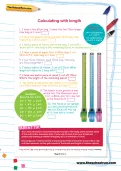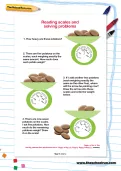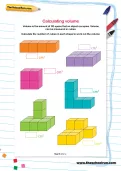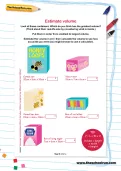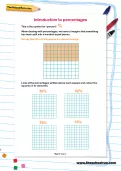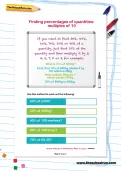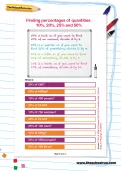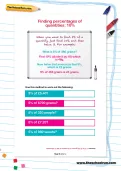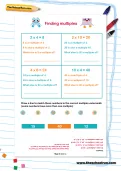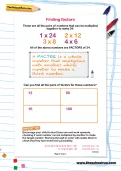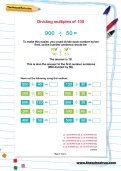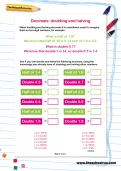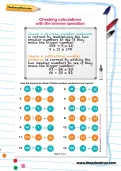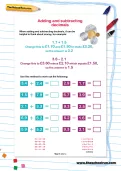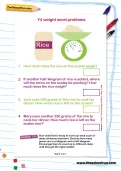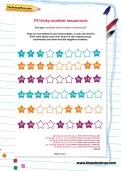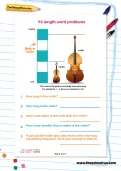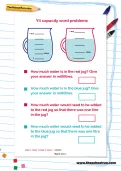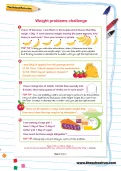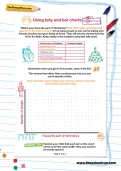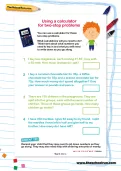The grid method is a good way to multiply three digits by one digit. To do this you will need to partition your numbers and put them in a table. Can you use the grid method to work out these sums?
or
Register to add to your saved resources
Already a subscriber? to view this content.
Have a look at these instructions on how to measure using a protractor. Can you measure these angles using a protractor?
or
Register to add to your saved resources
Already a subscriber? to view this content.
When dealing with percentages, we have to imagine that something has been split into a hundred equal pieces. Look at the percentages written above each square and colour the squares in to show the correct percent.
or
Register to add to your saved resources
If you need to find 30%, 40%, 60%, 70%, 80% or 90% of a quantity, just find 10% of the quantity and then multiply it by 3, 4, 6, 7, 8 or 9. Use this method to work out these sums.
or
Register to add to your saved resources
Already a subscriber? to view this content.
A KS2 maths worksheet created by a primary school teacher to help your Year 6 child with percentages and how to find 10%, 20%, 25% and 50% of quantities.
or
Register to add to your saved resources
Already a subscriber? to view this content.
When you want to find 5% of a quantity, just find 10% and then halve it. Use this method to work out these sums.
or
Register to add to your saved resources
Already a subscriber? to view this content.
Draw a line to match these numbers to the correct multiple underneath. (Remember, some numbers have more than one multiple.)
or
Register to add to your saved resources
A FACTOR is a whole number that multiplies with another whole number to make a third number. Can you find all the pairs of factors for these numbers?
or
Register to add to your saved resources
Already a subscriber? to view this content.
When dividing multiples of 100 it can be easier to divide each number by ten first. Can you work out these sums using this method?
or
Register to add to your saved resources
When doubling and halving decimals it is sometimes easier to imagine them as two-digit numbers. See if you can double and halve the following decimals, using the knowledge you already have of doubling and halving other numbers.
or
Register to add to your saved resources
Already a subscriber? to view this content.
Can you use the inverse to check if these number sentences are correct? Remember: check a division number sentence is correct by multiplying the two smaller numbers to see if they make the bigger number; check a subtraction number sentence by adding the two smaller numbers to see if they make the bigger number.
or
Register to add to your saved resources
Already a subscriber? to view this content.
When adding and subtracting decimals, it can be helpful to think about money. For example: 1.7 + 1.5. Change this to £1.70 and £1.50 to make £3.20, so the answer is 3.2. Use this method to work out these sums.
or
Register to add to your saved resources
Already a subscriber? to view this content.
Can you work out these weight word problems using kilograms and grams? You'll need to remember how many grams are in a kilogram and a half kilogram.
or
Register to add to your saved resources
Already a subscriber? to view this content.
Can you complete these number sequences? They are not related to your times tables, so you will need to think hard about each one! Some of the sequences go backwards and some include negative numbers.
or
Register to add to your saved resources
Can you answer these word problems using centimetres and metres?
or
Register to add to your saved resources
Already a subscriber? to view this content.
Can you solve these capacity problems using millilitres and litres?
or
Register to add to your saved resources
Can you solve these weight problems? To help you, you might need to change kg into g.
or
Register to add to your saved resources
Already a subscriber? to view this content.
Can you put these numbers into this Venn diagram? Now put the same numbers into this Carroll Diagram. Think about each number in turn and then cross it off when you have put it into the correct place. It may help to write a list of multiples of 7 and 5 before you start.
or
Register to add to your saved resources
Already a subscriber? to view this content.
What’s your favourite part of Christmas? Find information about the best aspects of the festive season for as many people as you can by asking your friends at school and your family at home. They will need to choose from the list in the table. Keep a tally of the numbers using this tally chart. Now use these axes to draw your own bar chart to show the information you have found.
or
Register to add to your saved resources
You can use a calculator for these two-step problems. What calculations will you need to do? Think hard about what numbers you need to key in and what you will need to write down as you go along.
or
Register to add to your saved resources
Already a subscriber? to view this content.
